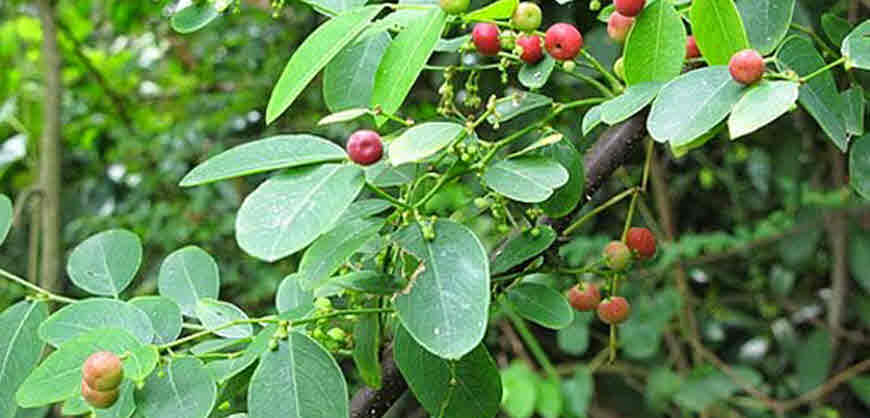Breynia retusa (synonym Breynia patens) is found growing in the scrub lands in rocky hill slopes, roadsides or clearings in sunny places. In Sanskrit this plant is known as Bahupraja as it produces seedlings in abundance, and Bahupushpa due to large number of flowers.

It is a medicinal plant, and has found a predominant use in indigenous, traditional folklore medicines. It is used in the treatment Conjunctivitis, lipoma (tumor), prickly heat, blood diseases, bowel disorders, nervous system disorders, insect bites, animal bites, complications of diabetes, skin diseases, and inflammation.
General Information
Plant Description: It is monoecious spreading much branched shrub or small tree. The branches are arching outwards, branchlets are slender, angular spreading, almost horizontal, smooth, and grey.
Leaves are distichous, 1.3-2.8 x 0.8-1.6 cm, broadly elliptic, membranous, obtuse, light green above, drying brown, paler beneath, main nerves in 3-5 pairs. Petioles is 1.6 mm long, and glabrous.
The flowers are small, greenish-yellow, and occur in axillary fascicles. Male flowers are pedicellate, 1 to few in proximal leaf axils, pedicels 4-8 mm long. Female flowers are greenish, solitary in distal axils, pedicels 3-4 mm long, shorter than in the male, pendulous at first, becoming erect until fruit borne on upper side of branchlets.
- Fruit is depressed-globose capsule, covered by enlarged, spreading fruiting perianth, 13-17 mm in diameter, faintly 3-lobed, orange-red, fleshy but dehiscent.
- Part(s) used for medicinal purpose: Leaves
- Plant type / Growth Habit: Spreading shrub
- Duration: Perennial
- Distribution: India, Myanmar, Sri Lanka
- Habitat: Open hill slopes, and plains
- Flowering, and fruiting: Throughout the year.
- Propagation, and management: Propagation is done by seeds
Vernacular names / Synonyms
- Scientific name: Breynia patens (Roxb.) Rolfe
- Sanskrit: Bahupraja, Bahupushpa, Kamboji
- Kannada: Kamboji
- Malayalam: Aattacherukola, Ekdania
- Bengali: Silpati
- Marma: Rownee
- Chakma: Hamussa Gach, Mach Chok Bichi Gach
- Tripura: Satamsakatoma, Taipak
- Khumi: Aghkamchi
Scientific Classification
The botanical name of Kamboji is Breynia patens. It belongs to plant family Euphorbiaceae. Below is given taxonomical classification of the plant.
- Kingdom: Plantae – Plants
- Subkingdom: Tracheobionta – Vascular plants
- Superdivision: Spermatophyta – Seed plants
- Division: Magnoliophyta – Flowering plants
- Class: Magnoliopsida – Dicotyledons
- Subclass: Rosidae
- Order: Euphorbiales
- Family: Euphorbiaceae – Spurge family
- Genus: Breynia J.R. Forst. & G. Forst. – breynia
- Species: Breynia patens (Roxb.) Rolfe
Synonyms
- Breynia retusa (Dennst.) Alston.
- Phyllanthus retuses Dennst.
- Phyllanthus patens Roxb.
Medicinal Uses of Breynia patens / Kamboji
Breynia patens is used in the treatment of a variety of ailments such as body pain, skin inflammation, hyperglycemia, diarrhea, dysentery, and toothache. The stem juice is used in conjunctivitis. The poultice of leaves is antimicrobial, and applied on boils for quicker suppuration or pus forming. The fruits are given in dysentery. The roots are beneficial in fits.
Anti-abortifacient, preventing miscarriage, lactogenic
Leptaden, herbal drug containing jeevanti (Leptadenia reticulata) 150 mg, and Kamboji (breynia patens) 150 mg is given.
Boils
Leaves are applied to hasten suppuration.
Body pain, skin inflammation, hyperglycemia, diarrhea, for diuresis
Macerated leaf juice is taken.
Gastritis
Juice extracted from leaves is taken.
Piles
The extract from leaves is used once a day.
Protein in urine
Leaf ground with milk, and is given once in the morning for 1 weak.
Skin diseases
Tender shoots, and leaves are ground with milk, and given once a day.
Tooth pain, gum problem
Boil the leaves in water. Use this water for gargeling.
Wounds by animal attack (tiger, dogs, etc.)
Bhantaka (Clerodendrum inforrunatam), and Soap nut Acacia (Acacia sinuata) leaves are taken in equal amount, and fried. This preparation is ground, and applied to wounds caused by tiger in cattle.
Looking for Krishna kamboji plant
Please provide contact number